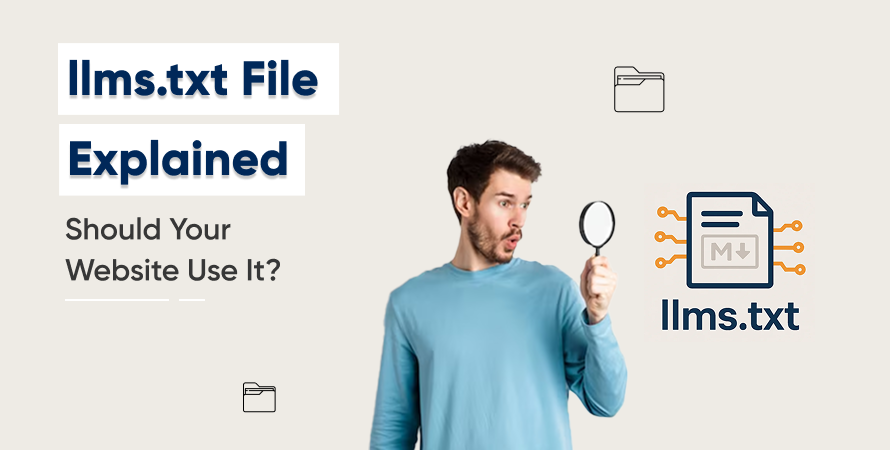llms.txt File Explained: Should Your Website Use It?



Introduction
As artificial intelligence becomes more common online, it’s raising new questions about how websites share their data. One important topic gaining attention is the llms.txt file. This is a simple text file that gives website owners more control over whether AI tools—like ChatGPT or Google Gemini—can use their content to train their systems.
In this blog, we’ll break down what the llm text file is, why it matters, and whether you need one for your website. You’ll learn how to use it, how to create it, and why it’s becoming an important part of managing your online content.
If you run a website, whether you’re a business owner, developer, or SEO expert, understanding llms.txt can help protect your content and get your site ready for the future of AI.
llms.txt File: Definition
The llms.txt file means a new type of plain-text file that allows website owners to declare whether they grant or deny permission for large language models (LLMs) to use their content. It works similarly to robots.txt, which controls how search engine crawlers interact with a site.
The concept of llms.txt was proposed to provide a standardized way to communicate with AI crawlers operated by companies like OpenAI, Google DeepMind, Anthropic, Meta, and others. These models often ingest web data to improve their capabilities. While AI developers previously harvested web content indiscriminately, there’s now increasing pressure from regulators and content creators to create boundaries. The llms.txt file is one such boundary.
Placed at the root of a domain (i.e., https://yoursite.com/llms.txt), this file lists permissions and restrictions for specific AI bots. The contents are readable and interpretable by both humans and machines, making it a simple yet powerful tool for digital governance.
Why Was llms.txt Introduced?
As AI tools grow rapidly, there’s growing concern about how they collect large amounts of data. Most large language models are trained on massive datasets scraped from the internet—ranging from academic articles to social media posts and even original content from bloggers and publishers.
As these models become more powerful and widely used, questions about consent and data ethics have become more urgent. Many content creators now ask:
- Was my content used to train this model?
- Did I give permission?
- Can I choose to opt out?
In response to these concerns—and increasing regulatory pressure—some AI companies are starting to respect digital content boundaries. While tools like robots.txt help manage traditional web crawlers, they weren’t built for AI.
That’s where llms txt comes in: a new, more targeted way for publishers to control how AI systems access their content.
Do You Actually Need an llms.txt File for Your Website?
The short answer: it depends.
The long answer is more nuanced. The llms.txt file is still relatively new, and not all AI companies have committed to fully respecting it. However, some leading organizations, including OpenAI and Google DeepMind, have begun encouraging its use and claim to honor its rules.
Here are some factors to consider when deciding if you need it:
You likely need it if:
- Your website publishes original content, such as news, blog posts, research, or creative work.
- You’re concerned about copyright, licensing, or monetization of your content.
- You want to take a proactive stance on AI ethics and digital ownership.
- You operate in sectors like education, journalism, or creative writing where content integrity is paramount.
You may not need it if:
- Your website contains only static business information or promotional material.
- Your content is already publicly licensed (e.g., Creative Commons).
- You’re indifferent to AI systems using your content for training.
That said, it’s wise to consider implementing an llms.txt file as a forward-looking move. Even if AI crawlers aren’t fully compliant today, the trend is leaning toward more transparency and opt-in models. By putting the file in place now, you prepare your site for the future while signaling your stance on content usage.
Creating llms txt File for Your Website – Step-by-Step Guide
You don’t need complex tools or software to generate an llms.txt file. It’s a simple text file that you can create using any text editor (like Notepad, Sublime Text, or VS Code).
Here’s how to do it:
Step 1: Open a Text Editor
Start by opening a plain-text editor. Avoid using Word or rich-text editors that add hidden formatting.
Step 2: Write the AI Crawler Rules
Use the following structure to specify which LLMs you allow or disallow:
User-Agent: OpenAI
Disallow: /
User-Agent: GoogleAI
Allow: /
User-Agent: Anthropic
Disallow: /
Each section includes a User-Agent, which is the name of the AI bot, followed by either Allow: / or Disallow: /. The / indicates the root of your website. You can get more granular if needed by listing specific directories.
Step 3: Save the File as llms.txt
Name the file exactly llms.txt (not .txt.txt or llms.txt.doc). Ensure it is saved in plain txt file format.
Step 4: Upload to Root Directory
Using an FTP client or your web hosting platform’s file manager, upload the file to the root of your domain (same directory as your robots.txt file).
Your file should be publicly accessible at:
https://yourdomain.com/llms.txt
Step 5: Test the File
Visit the URL in your browser to ensure it displays correctly. Also, periodically review the AI crawlers’ guidelines for updates to their user-agent strings.
Use a llms.txt Generator (For Non-Technical Users)
If you’re not comfortable editing and uploading files manually, you can use an llms.txt generator tool. These online generators simplify the process by allowing you to check boxes for each AI company and automatically generate the correct syntax.
While the tools available are still evolving, many of them are similar to robots.txt generators and function in the same way. You select which AI companies to allow or block, and the tool outputs the correct txt formatting.
Pros of using a generator:
- Saves time
- Reduces chances of syntax errors
- Easy for non-technical users
Cons:
- May not be as customizable
- Some may not stay updated with new AI user-agents
Using a trusted llms.txt generator can be a great way to get started, especially if you’re not familiar with web servers or file systems.
Will AI Models Actually Respect the llms.txt File?
This is a valid concern—and one that underscores the current transitional state of AI data ethics.
At the time of writing, OpenAI has announced support for llms.txt and has stated that its GPT bots will respect the permissions specified in the file. Google DeepMind and Anthropic have expressed similar intentions, though consistency and enforcement remain unclear.
However, not all AI companies are on board. There are also questions about whether web crawlers from smaller or less transparent companies will honor the file.
It’s important to understand that llms.txt is not enforceable by law (yet), and its effectiveness depends largely on voluntary compliance. Still, including the file:
- Signals your expectations clearly.
- Helps you build a paper trail of responsible content governance.
- Might be used by future tools and browsers to alert users when visiting AI-compliant sites.
In the long run, regulatory frameworks might enforce respect for these declarations, making early adoption a smart move.
Potential Risks and Benefits of Using llms.txt
Like any emerging web standard, using llms.txt comes with both upsides and downsides.
Benefits:
- Control: You set the terms for how your content is used.
- Ethics: Aligns your site with responsible AI usage.
- Compliance: Prepares your site for future regulations.
- Signal: Communicates your position to AI companies and your audience.
Risks:
- Reduced Exposure: Blocking AI models may mean your content isn’t used for emerging AI search tools or summaries.
- False Sense of Security: Not all crawlers will comply.
- Technical Misconfiguration: Incorrectly setting up the file could unintentionally block or allow access.
Overall, the benefits outweigh the risks if you manage your llms.txt file carefully and review it periodically.
Conclusion
The llms.txt file isn’t just a trend—it’s a smart step toward protecting your content in the age of AI. While not legally required yet, it gives creators a simple way to set boundaries with AI systems.
Whether you run a blog, eCommerce site, or online publication, adding llms.txt helps you take control of how your content is used. It’s easy to implement and future-focused.
To make your site both AI-ready and optimized for speed, SEO, and user experience, consider working with experts. Hire Core Web Vitals Consultants to ensure your website meets today’s standards—and tomorrow’s.
Frequently Asked Questions (FAQs)
If you don’t implement llms.txt, AI crawlers may assume implicit permission to access your site, depending on their policies. This means your content could be used to train LLMs without explicit consent.
No, llms.txt is not currently enforceable by law. It serves as a public declaration of your preferences, which ethical AI companies may choose to respect.
No, llms.txt is separate from search engine behavior and does not impact traditional SEO or rankings in Google or Bing search results.
Yes, the structure of the file allows you to tailor access per AI bot. You can disallow one while allowing another, depending on your preferences.
You can manually create a plain-text file using a text editor or use a trusted llms.txt generator. Make sure it is uploaded to the root directory of your domain and tested for accuracy.